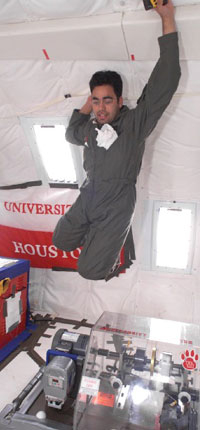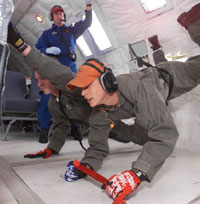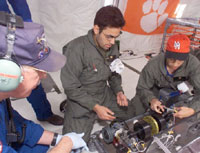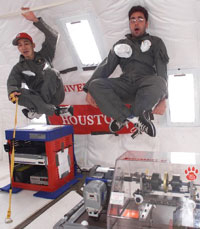A team of students from the University of Houston Cullen College of Engineering got a chance to make their mark on technology that could be used aboard the International Space Station or during a Mars mission as they conducted zero-gravity experiments in NASA’s so-called “Vomit Comet” on March 1-2, 2001.
Moses Navarro, Jainik Shah, Brian Stalcup and Oscar G. Herdocia flew aboard a KC-135A aircraft out of Ellington Field as part of NASA’s Reduced Gravity Student Flight Opportunities Program. The young scholars are part of a team of seven UH students supervised by professor of mechanical engineering David Zimmerman who have developed the ZGraMM – or Zero Gravity Machinery Monitoring experiment.
Zimmerman says the objective of the experiment was to develop a database of zero-gravity machinery ‘fault’ signatures that can be used to gauge whether a piece of equipment aboard a spacecraft might be failing or faltering.
“We want to see if there’s a difference in how a machinery’s vibrations are measured in zero-g and on the ground in one-g,” explained Zimmerman. “While it’s possible to predict when maintenance will be needed for machinery on a spacecraft based on tests on earth, the situation may be different in zero-gravity.”
The experimental test-bed consists of a rotating machine, along with necessary signal conditioning and data recording devices. The simulator allows for the rapid introduction of several faults, including rotating imbalance, shaft misalignment, gear box failures and bent shafts.
The UH crew is one of 48 teams of college students from around the country carrying out experiments aboard the NASA aircraft this year. The reduced gravity environment is obtained using a specially modified transport jet, which flies roller coaster-like parabolic arcs over the Gulf of Mexico to produce weightless periods of 20-25 seconds. The aircraft will make two- to three-hour flights, performing about 30 parabolas.
The students have been preparing and training for the experiment for several months, running through the logistics of recording their measurements and going through trial simulations. The last two weeks have involved pre-flight training, assembly and testing of the equipment.
In addition to Navarro, Shah, Stalcup and Herdocia, who get to fly aboard the NASA aircraft to operate ZgraMM, ground team members include engineering students Ruben Morin, Brian Sidle and Jason Berrio.
“This really offers a once in a lifetime educational opportunity for most of these students,” said Zimmerman. “While it gives them a unique perspective on the science and engineering involved in the space program, they get some valuable lessons in planning and organizing, and what real-life engineering projects require in terms of safety, responsibilities, time and resources.”
UH students flying on previous reduced gravity flights have conducted experiments dealing with space debris, damage evaluation and space station maintenance.



